Health at Home
Home Health Perceptions
Having been inside our homes for the most part of 2020 and starting off the new year, we’ve had more time to reflect on the quality of our living space. On the topic of home health hazards, a little over 1,000 participants were surveyed to determine their concerns about home-related problems as well as their strategies to solve any they’ve encountered.
We’ll find out how different age groups respond to various hazards, such as water leakage, mold, and pests. Also, will they tackle the job themselves or have a professional come in to deal with it? How much will they invest in the safety of their homes? These questions, and more, will help us understand how seriously people are invested in their home health as well as their own.
An Overview
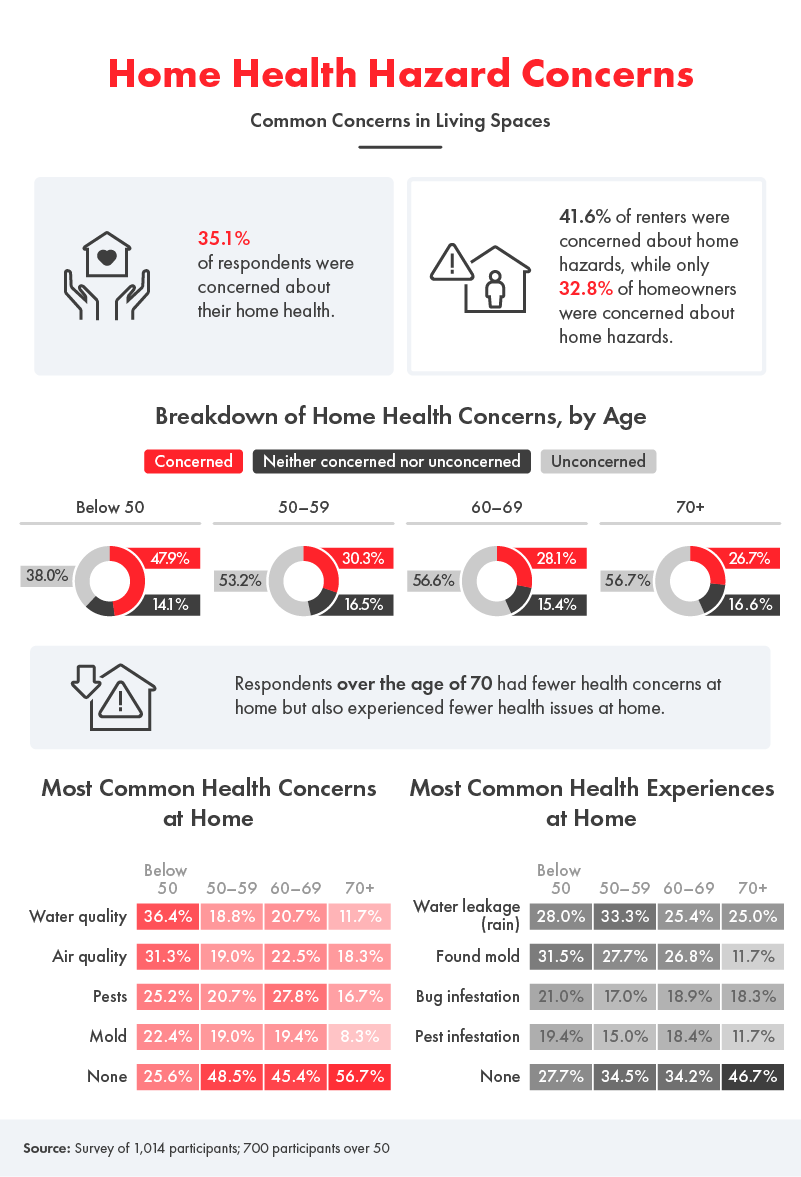
Regardless of age, just over 35% of respondents were worried about the health of their home. The most concerned were those younger than 50, with 47.9% feeling a little bothered. Those older than 50 were a little less worried – on average, around 28% of them felt concerned. Those over the age of 70 had the least number of concerns, perhaps due to the fact that they’ve come into contact with fewer home health issues than their younger counterparts.
Respondents 50 or younger were most concerned about the water and air quality of their home. The majority of the older respondents weren’t uneasy about anything, but those in their 60s were significantly more perturbed about pests than the rest. Termites, for example, infest around 600,000 homes in the U.S. each year and cause residents upward of $5 billion in property damage and pest control efforts annually.
In terms of actual health hazard experiences, while older generations had been less affected than those younger than 50, many of them still experienced water leakage due to rain. The annual cost of water damage in the U.S. is in the $13 billion range, and an average of 14,000 Americans face an emergency of this type each day.
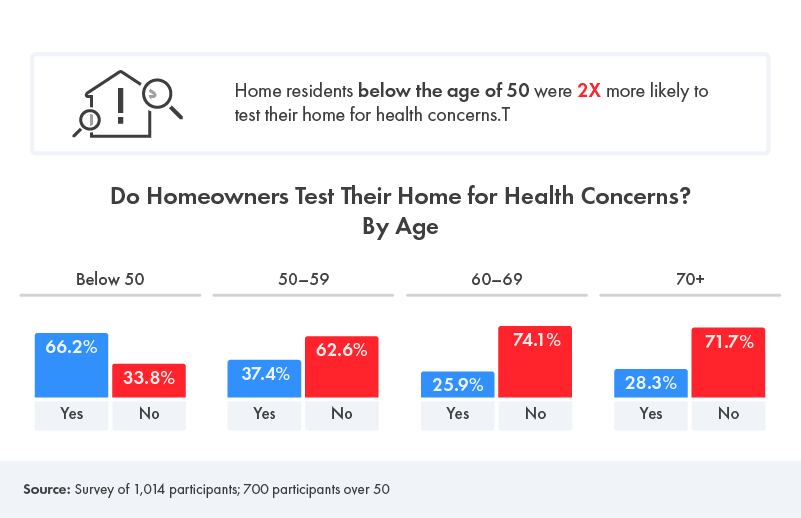
Additionally, respondents younger than 50 were much more likely to conduct various tests on their homes to make sure there were no health concerns that might be afoot. While over 66% of them were in favor of checking up on their house, the next most concerned people were those in their 50s, where only 37.4% of them wanted to be absolutely sure they were living in a safe space.
Solving the Issues
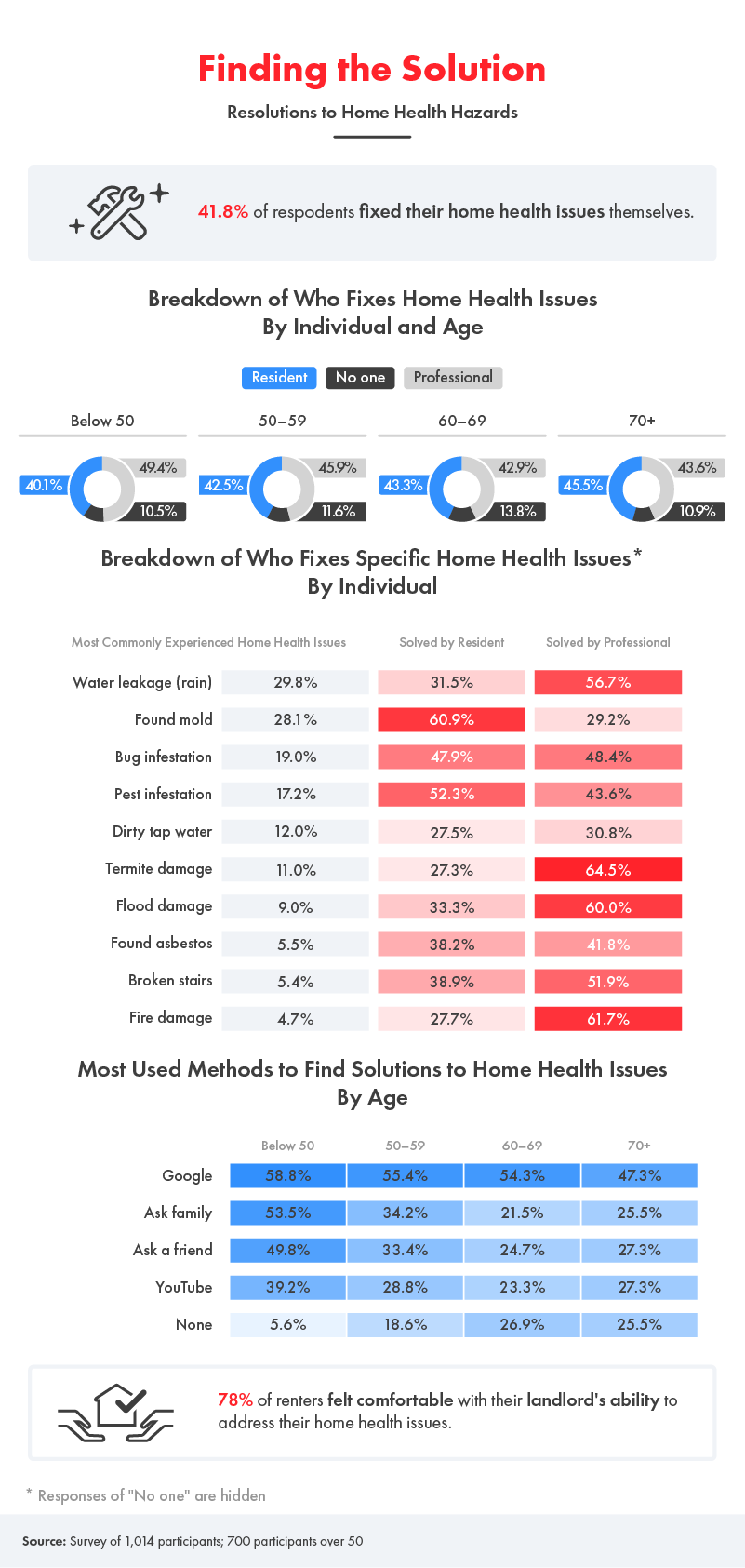
If there was a health-related issue in their home, almost 42% of respondents will have fixed it themselves. The distribution remains fairly similar across age groups – ranging between 40.1% (under 50) to 45.5% (over 70). Otherwise, homeowners called in a professional, and a small percentage of them just left the issue alone altogether.
The top two most common home health issues respondents dealt with were water leakage from rain (29.8%) and finding mold (28.1%). Out of all the listed issues, residents were able to fix the mold issue by themselves most frequently (60.9% of them). A number of home remedies can be useful to get rid of mold, including baking soda solutions, vinegar, hydrogen peroxide, and even lemon juice!
Homeowners were often stumped when dealing with termite infestations, and professional help was needed for 64.5% of respondents. Termite treatment is considered to be one of the more complex operations in the pest-killing business and is therefore recommended to be done by an exterminator.
Across all age groups, Google was the most common research method when it came to finding home health solutions. Those younger than 50 used the search engine, asked family and friends, and consulted YouTube more than older respondents.
Worried About What?
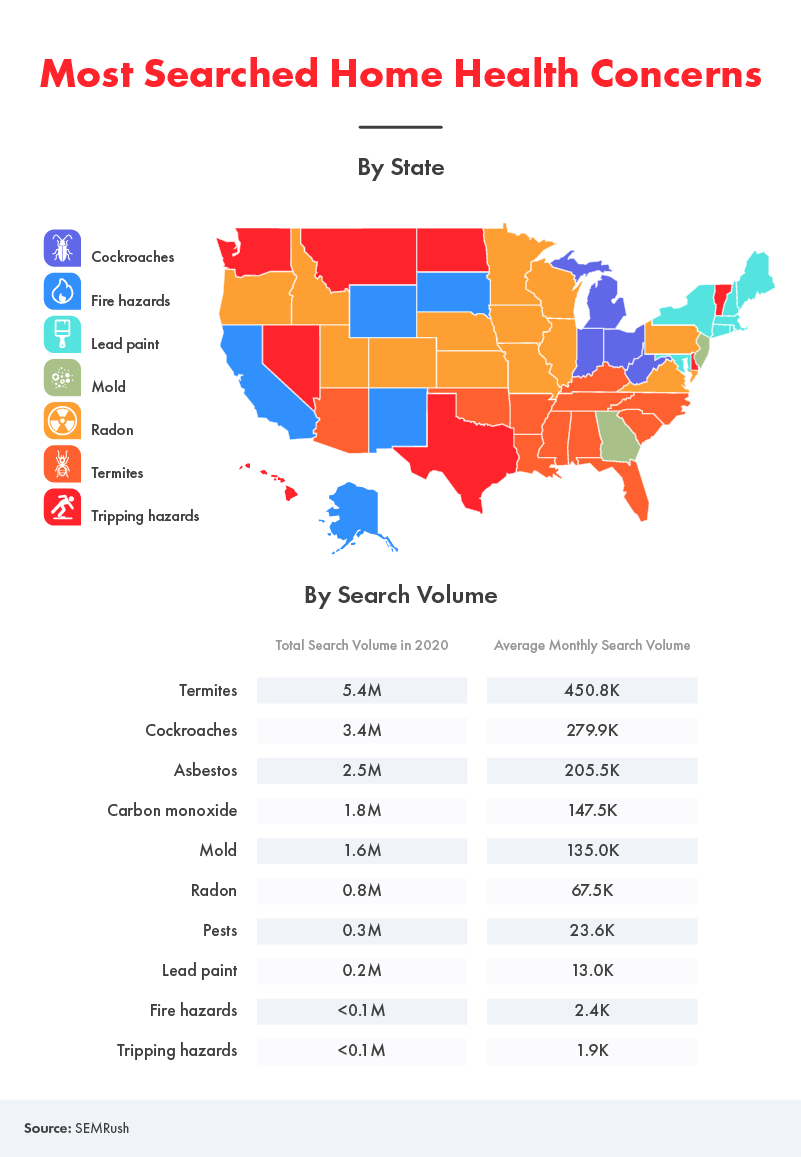
According to SEMRush, the most searched home health concern in 2020 was the keyword ‘termites,’ at 5.41 million clicks – this was consistent for most Southern states in the U.S. Termites thrive in warm locations, which explains why Southeastern U.S. states have the most problems with them. They are also more drawn to humid and damp environments, which is why the Southwest and Northern states aren’t hit as hard. Researchers at the University of Florida have predicted that half of the homes in Southern Florida might encounter a termite issue within the next 20 years.
Other high-volume searches in 2020 included cockroaches at 3.36 million – Midwest states such as Michigan, Illinois, and Ohio had the most issues with them. Meanwhile, 2.5 million people researched asbestos, 1.8 million looked up carbon monoxide, and 1.6 million wanted to know more about mold.
The Keywords
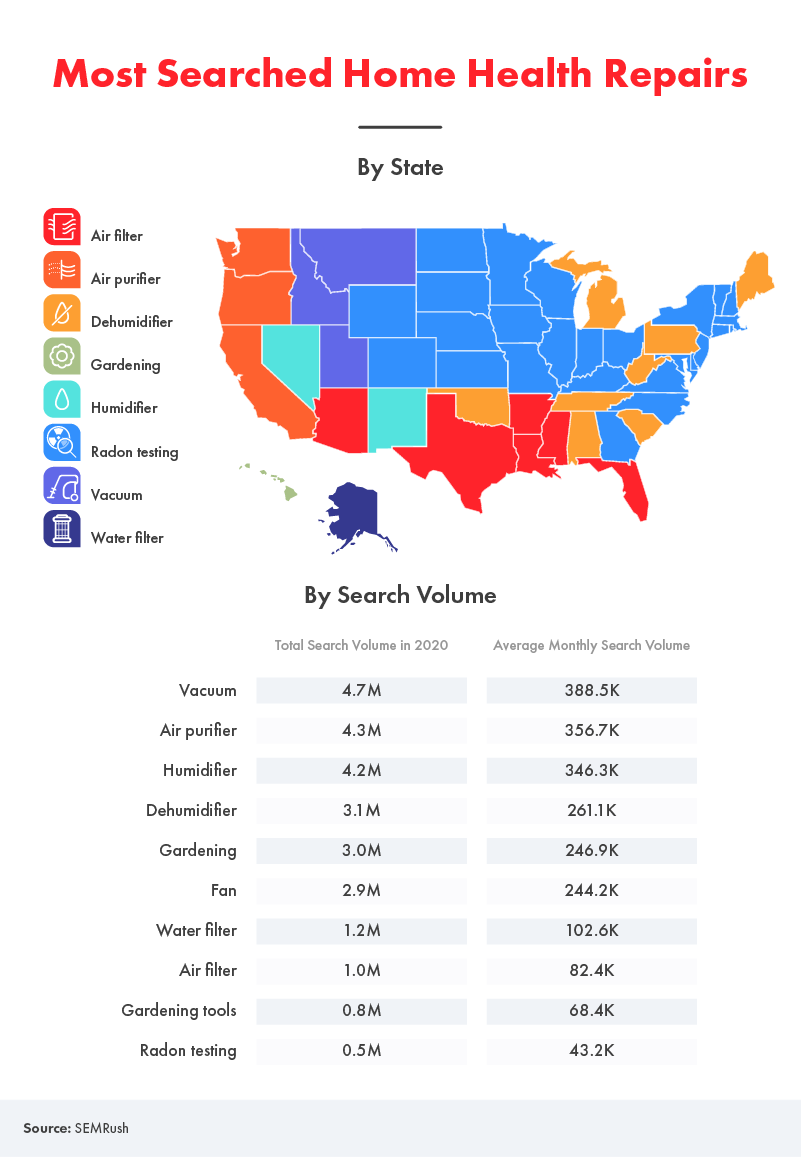
Regarding repairs needed to be done to improve home health, vacuums, air purifiers, and humidifiers all had well over 4 million online searches in 2020, according to SEMrush. The advantages of vacuuming are obvious, but humidifiers and air purifiers have particular home health benefits that people should be aware of. For example, humidifiers can help maintain the integrity of your home’s furniture and prevent static electricity from building up, while air purifiers can help filter out mold particles and other indoor toxins.
Although radon testing was only searched about 520,000 times in 2020, it accounted for the most repairs across almost the entire Midwest and many states farther east. Seeing as radon is the second leading cause of lung cancer deaths, after smoking, and about 1 in 15 homes have high levels of it, it’s no surprise that people across the country are making sure their residences are free from it.
The Cost of Cleanliness
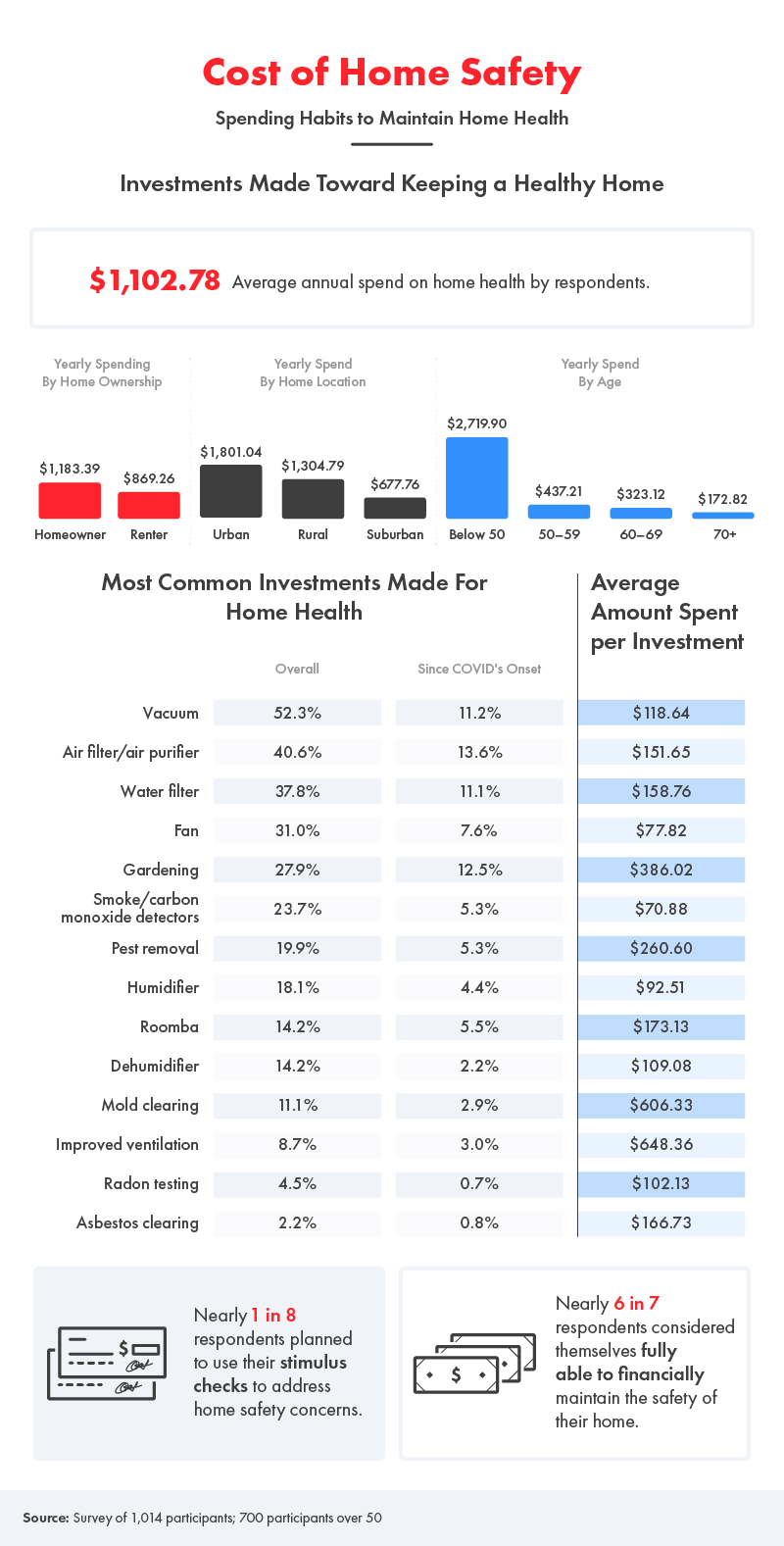
To help keep their homes in tip-top shape, respondents shelled out just over $1,100 yearly. Homeowners spent a little over $300 more, on average, than renters. Regarding the home location, urban households spent the most, followed by rural and then suburban ones. People younger than 50 also spent significantly more than older generations – their average was $2,719.90, a full $2,282.69 higher than the next highest age group (50’s).
Generally, the most common investment for home health improvement was the purchase of a vacuum, according to 52.3% of respondents. Since the start of the pandemic, there has been a 13.6% uptick in air filter/purifier investment, which can help reduce the transmission of COVID-19. Gardening had the second-highest increase, at 12.5% – it has become a hobby of many during these trying times.
On average, those younger than 50 and aged between 60 and 69 invested the most in mold clearing ($921.69), 50- to 59-year-olds were most concerned with improving their ventilation ($957.08), and people 70 years of age or older spent $1,000 on asbestos clearing.
Home Safety
Clearly, the year of isolation has given us enough time to collect data based on people’s concerns, perceptions, and reactions toward home health hazards. People younger than 50 tended to be more concerned about these problems and subsequently invested more in fixing their home-related issues. Regardless of age, though, everyone had been affected by a hazard at some point and had to tackle it one way or another.
Also, while some ‘do it yourself’ methods are appropriate for tackling health hazards, sometimes it is better to call in a professional – when it comes to safety, you can never go wrong by consulting one. Even if your home is healthy, you need to look after yourself as well. The experts at Stannah can help you do exactly that. With over 40 years of experience, they have set the standards in stairlift design and safety. If you or someone you know needs this sort of assistance, Stannah’s industry prowess speaks for itself – head over now to find out more about their mission and how they could change your life for the better.
Methodology and Limitations
For the first half of the study, we collected responses from 1,014 homeowners and renters using Amazon MTurk. Of all respondents, 69% were over the age of 50. Of the 1,014 respondents, 56% were female, and 44% were male. Additionally, the average age of respondents was 51.8 with a standard deviation of 12.9 years.
The main limitation of this portion of the study is the reliance on self-report, which is faced with several issues, such as, but not limited to, attribution, exaggeration, recency bias, and telescoping. Data is solely representative of self-reported claims by homeowners and renters. This survey ran during January 2021.
For the next half of the study, we used SEMrush (www.semrush.com) to pull Google Search data for the volume of home safety concerns and home repairs. The terms used for home safety concerns included the following: “bad air quality,” “poor air quality,” “bad water quality,” “poor water quality,” “asbestos,” “mold,” “poor ventilation,” “bad ventilation,” “faulty smoke detectors,” “smoke detector not working,” “carbon monoxide,” “falling hazards,” “tripping hazards,” “fire hazards,” “lead paint,” “pests,” “cockroaches,” “termites,” “radon,” “tobacco smoke,” and “cigarette smoke.” The terms used for home repairs included these: “vacuum,” “roomba,” “fan,” “air filter,” “air purifier,” “water filter,” “asbestos clearing,” “mold clearing,” “improve ventilation,” “new smoke detectors,” “new carbon monoxide detectors,” “pest removal,” “extermination,” “radon testing,” “radon tester,” “humidifier,” “dehumidifier,” “gardening,” and “gardening tools.”
Fair Use Statement
Now that you know about the importance of home health, feel free to share this article with friends or family who could benefit from it. We only ask that you do so for non-commercial use and that a link is provided back to the original page so contributors can earn credit for their work!

 USA
USA